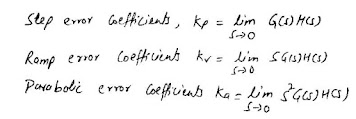This section of Control Systems Multiple Choice Questions and Answers (MCQs) focuses on ” Steady-state error”.It will help you to prepare for various competitive exams.
CONTROL SYSTEM – STEADY STATE ERROR MCQs
1. When the gain of the control system increases, the steady-state error of the system:
Explanation:- The steady-state error of a control system is inversely proportional to the system gain. So as the gain increases, the steady-state error decreases.
2. For type-2 system the steady state error due unit ramp input is:
Explanation:- For type-2 system, the steady-state error for a unit step input is 0; for unit ramp input is 0, and for unit parabolic input is 1/k.
3.Type-1 system gives infinite steady state error for the………….input.
Explanation:- Type-1 system gives 0 steady-state error for the unit step input, 1/k steady-state error for the unit ramp input, and infinite steady-state error for the unit parabolic input.
4.The open-loop gain for a unity feedback system is G(s) = 10/s(s+2), the velocity error constant of the system is:
Explanation:- The velocity error constant is calculated by using the formula given below
5.Determine the type of the system for the G(s)= 10/s and H(s)=3/s .
Explanation:-The open-loop transfer function is given as G(s)H(s)=10/s x 3/s =30/s2 . As the s2 term appears in the denominator, It means that there are two poles at the origin. So it is a type-2 system.
6.For a unity feedback system having G(s)=35(s+6)/s(s+1)(s+7),determine steady state error for ramp input with magnitude 10.
Explanation:-Use the formula for velocity error coefficient as shown below and then calculate steady-state error (ess) by using formula ess= A/Kv = 10/30= 0.33.
7.The forward path transfer function of a unity feedback control system is given by G(s)=5(s2+ 2s+200) / s2(s+5)( s2+3s+10) .Determine the step,ramp and parabolic error coefficients.
Explanation:- By using the following formula we can calculate the step, ramp, and parabolic error coefficients
8. Which input is not acceptable for the Type-1 system?
Explanation:- As the steady-state error is infinite for a parabolic input. Hence parabolic input is not acceptable by the Type-1 system. But step input and ramp input is acceptable for Type-1 systems as steady-state error for these inputs are finite values i.e zero and 1/K respectively.
9. static error coefficient method is applicable only to the three input signals i.e step, ramp, and parabolic, and cannot give an error coefficient for other input signals.
Explanation:- static error coefficient method is applicable only to the three input signals i.e step, ramp, and parabolic, and cannot give an error coefficient for other input signals. This disadvantage can be overcome by the dynamic error coefficient.
10. Static error coefficient method is applicable only to:
Explanation:- The disadvantage of the static error coefficient method is that it is applicable only to stable systems.
More Related MCQ’s


